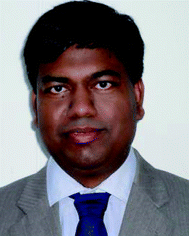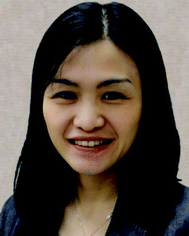Research presented at Symposium P of the 10th International Conference of Materials and Advanced Technology (ICMAT 2019)
Goutam Kumar
Dalapati
ab,
Lydia Helena
Wong
*c and
Frank Erich
Osterloh
d
aSRM University-AP, Amaravati, 522502, India
bCenter for Nanofibers and Nanotechnology, Faculty of Engineering, National University of Singapore, Singapore-117576
cSchool of Materials Science and Engineering, Nanyang Technological University, Singapore. E-mail: lydiawong@ntu.edu.sg
dDepartment of Chemistry, University of California Davis, USA
Abstract
Discovery and development of affordable renewable energy sources is of paramount importance for the continuous growth of human civilization while minimizing global warming. Converting solar energy to electricity or fuel presents a golden opportunity towards truly accessible, low cost and clean source of energy. Thin film inorganic materials may open up new opportunities in flexible solar cells, wearable technologies and building integrated photovoltaics (BIPV) beyond the traditional (silicon-based) solar panels installed on roof tops and solar farms. Conversion of sunlight into useful chemicals such as O2 and H2, enabled by photo(electro)chemical reactions of semiconductor photoelectrodes, also presents a promising opportunity to harvest solar energy. Towards this, we present a collection of selected articles on the recent development of chalcogenide based inorganic materials for solar energy harvesting which were presented at symposium P of the 10th International Conference of Materials and Advanced Technology (ICMAT2019) hosted by MRS-Singapore.
Among different inorganic materials, copper based materials have the potential to bring game changing solutions to the current industrial challenges related to energy production (solar cells, fuel cells), electrical energy storage (super-capacitors, batteries) and hydrogen storage. Copper kesterites based semiconductors such as copper-zinc-tin-sulphide (Cu2ZnSnS4, CZTS), copper-zinc-tin-selenide (Cu2ZnSnSe4, CZTSe) and copper-zinc-tin-sulpho-selenide (Cu2ZnSn(S,Se)4, CZTSSe) materials show exciting optical characteristics with significant potential for photovoltaic devices.1,2 They are easy to synthesise and can be integrated into flexible materials to be utilised for building integrated photovoltaic (BIPV) applications. Despite the sustainability and earth abundancy, the development of kesterite based solar cells are hindered by, among other things, (i) unoptimized interfaces, and (ii) presence of deep and shallow defects in the absorber.3,4 While the origins of the deep defects are presently still debatable, many have attributed this to the Cu–Zn, Cu–Sn and Zn–Sn antisites which prompted significant efforts to substitute Cu, Zn, Sn with other cations.5 In this collection, two of the most successful substitutes, Ag and Cd, were reported to have beneficial effect on monograin CZTS solar cells (DOI: 10.1039/c9ta07768e). The reason behind the superior performance of Cd-substituted CZTS is further elucidated by a combination of computational and structural characterizations, which reveal the effect of Cd on the cation redistribution in Cu2(Zn,Cd)SnS4 and show that Cu2CdSnS4 has less structural disorder than Cu2ZnSnS4 (DOI: 10.1039/c9ta09572a). Efforts to improve the performance by modifying the CZTS/ZnCdS interface is reported to achieve power conversion efficiency over 10% (DOI: 10.1039/c9ta09576d), while a flexible CZTSSe solar cells with power conversion efficiency of ∼10% was reported by implementing an oxide based diffusion barrier on stainless steel substrate (DOI: 10.1039/c9ta08265d). Lastly, we would also highlight a potential emerging binary chalcogenide, antimony sulfo-selenide (Sb2(S,Se)3), whose efficiency is approaching 10% (a review of record efficiency cells of this family of material is provided in ref. 6). One important prerequisite for the high efficiency of Sb2(S,Se)3 is the preferential growth in hk1 direction which is investigated carefully by Park et al. in this collection (DOI: 10.1039/c9ta08289a), while Yang and Moon provided a recent highlight of the use of Sb2Se3 as photocathode for solar to hydrogen generation (DOI: 10.1039/c9ta07990d).
Finally, we thank all contributing authors and reviewers of this themed collection, as well as Dr Christopher Dias (Publishing Editor) and Lynn Murphy (Deputy Editor) of the RSC whose assistance was invaluable to realize this themed collection.
References
- M. T. Winkler, et al., Optical designs that improve the efficiency of Cu2ZnSn(S, Se)4 solar cells, Energy Environ. Sci., 2014, 7, 1029–1036 RSC.
- C. Yan, et al., Cu2ZnSnS4 solar cells with over 10% power conversion efficiency enabled by heterojunction heat treatment, Nat. Energy, 2018, 3, 764–772 CrossRef CAS.
- M. Kumar, et al., Strategic review of secondary phases, defects and defect-complexes in kesterite CZTS–Se solar cells, Energy Environ. Sci., 2015, 8, 3134 RSC.
- S. Zhuk, et al., Critical review on sputter-deposited Cu2ZnSnS4 (CZTS) based thin film photovoltaic technology focusing on device architecture and absorber quality on the solar cells performance, Sol. Energy Mater. Sol. Cells, 2017, 171, 239 CrossRef CAS.
- Y. E. Romanyuk, et al., Doping and alloying of kesterites, Journal of Physics: Energy, 2019, 1, 044004 Search PubMed.
- L. H. Wong, et al., Emerging inorganic solar cell efficiency tables (Version 1), Journal of Physics: Energy, 2019, 1, 032001 Search PubMed.
| This journal is © The Royal Society of Chemistry 2020 |



